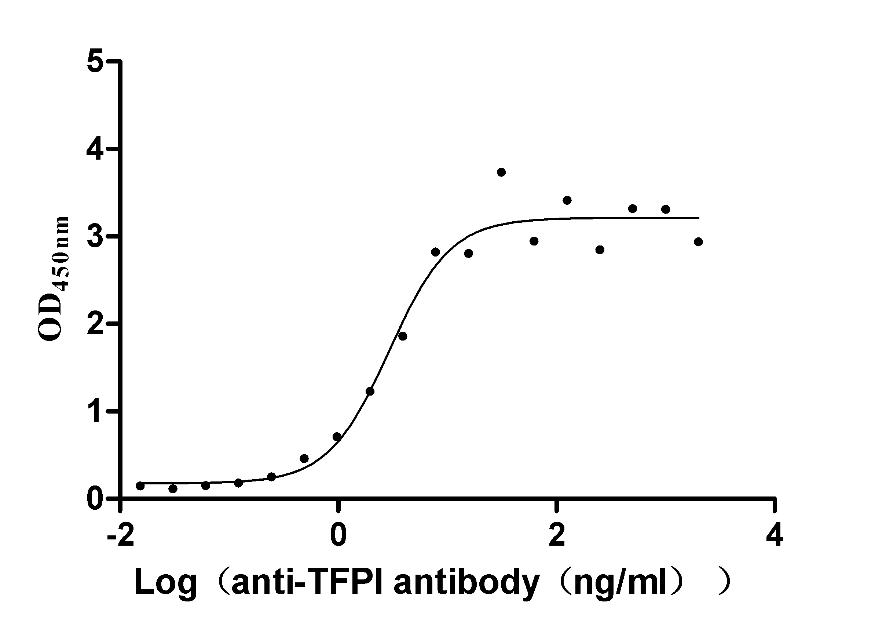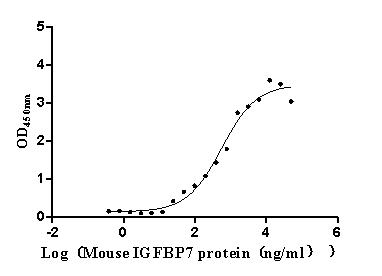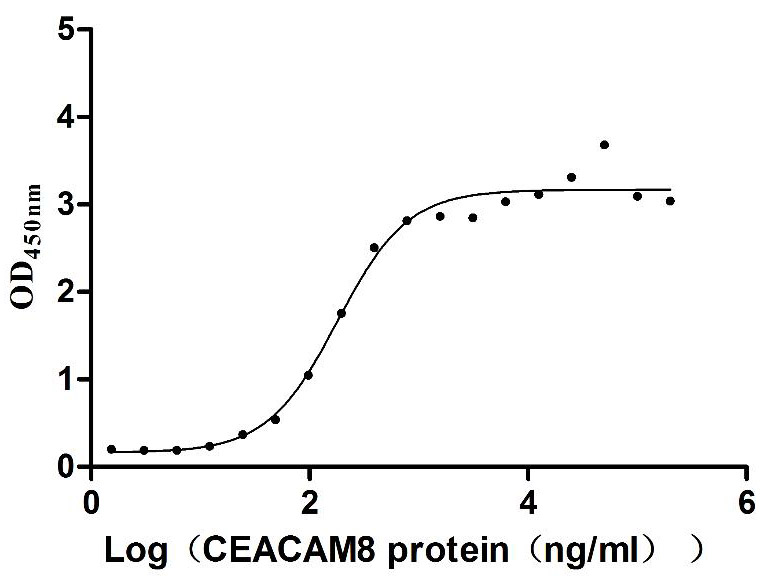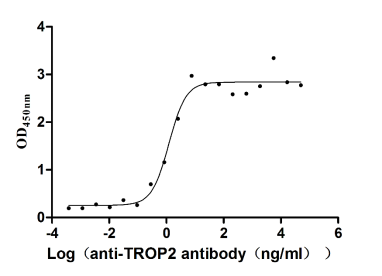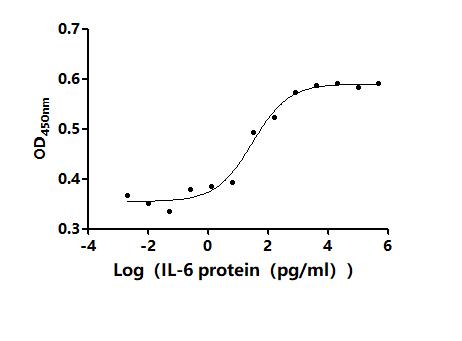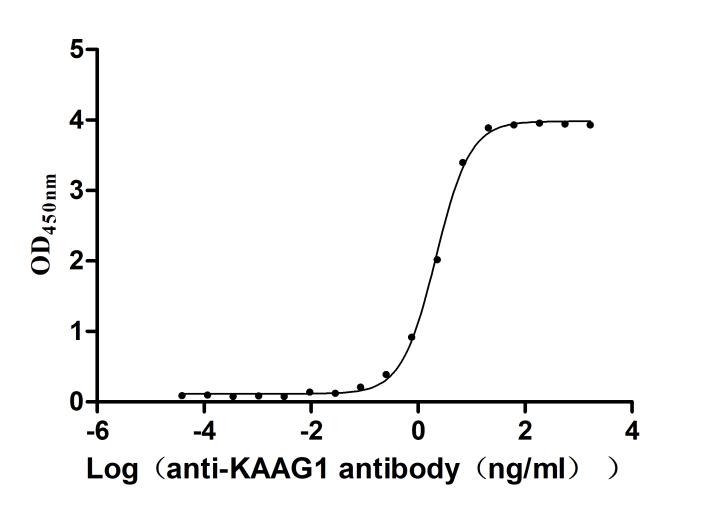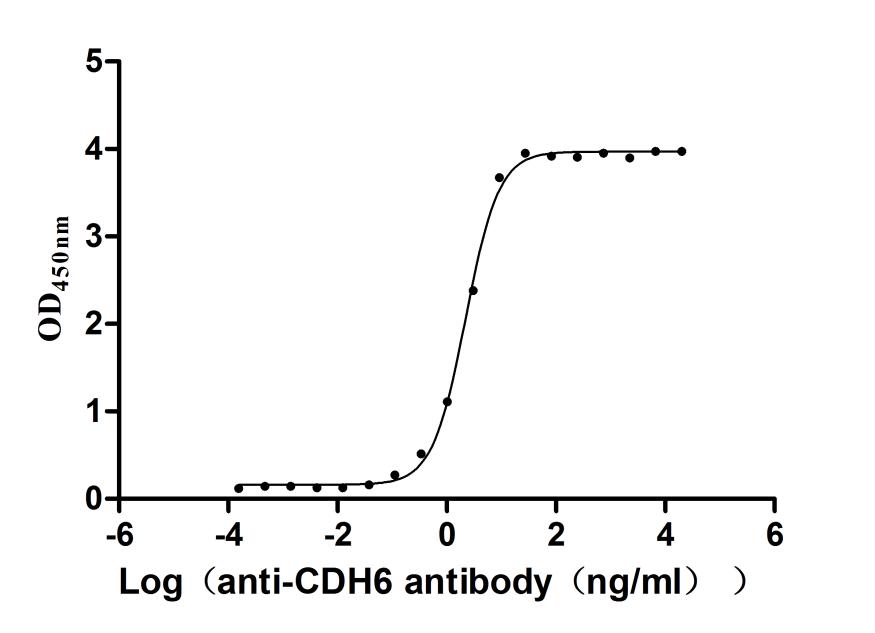Recombinant Mouse Serine/threonine-protein kinase D1 (Prkd1), partial
-
中文名称:小鼠Prkd1重组蛋白
-
货号:CSB-YP717251MO
-
规格:
-
来源:Yeast
-
其他:
-
中文名称:小鼠Prkd1重组蛋白
-
货号:CSB-EP717251MO
-
规格:
-
来源:E.coli
-
其他:
-
中文名称:小鼠Prkd1重组蛋白
-
货号:CSB-EP717251MO-B
-
规格:
-
来源:E.coli
-
共轭:Avi-tag Biotinylated
E. coli biotin ligase (BirA) is highly specific in covalently attaching biotin to the 15 amino acid AviTag peptide. This recombinant protein was biotinylated in vivo by AviTag-BirA technology, which method is BriA catalyzes amide linkage between the biotin and the specific lysine of the AviTag.
-
其他:
-
中文名称:小鼠Prkd1重组蛋白
-
货号:CSB-BP717251MO
-
规格:
-
来源:Baculovirus
-
其他:
-
中文名称:小鼠Prkd1重组蛋白
-
货号:CSB-MP717251MO
-
规格:
-
来源:Mammalian cell
-
其他:
产品详情
-
纯度:>85% (SDS-PAGE)
-
基因名:
-
Uniprot No.:
-
别名:Prkd1; Pkcm; Pkd; PrkcmSerine/threonine-protein kinase D1; EC 2.7.11.13; Protein kinase C mu type; Protein kinase D; nPKC-D1; nPKC-mu
-
种属:Mus musculus (Mouse)
-
蛋白长度:Partial
-
蛋白标签:Tag type will be determined during the manufacturing process.
The tag type will be determined during production process. If you have specified tag type, please tell us and we will develop the specified tag preferentially. -
产品提供形式:Lyophilized powder
Note: We will preferentially ship the format that we have in stock, however, if you have any special requirement for the format, please remark your requirement when placing the order, we will prepare according to your demand. -
复溶:We recommend that this vial be briefly centrifuged prior to opening to bring the contents to the bottom. Please reconstitute protein in deionized sterile water to a concentration of 0.1-1.0 mg/mL.We recommend to add 5-50% of glycerol (final concentration) and aliquot for long-term storage at -20℃/-80℃. Our default final concentration of glycerol is 50%. Customers could use it as reference.
-
储存条件:Store at -20°C/-80°C upon receipt, aliquoting is necessary for mutiple use. Avoid repeated freeze-thaw cycles.
-
保质期:The shelf life is related to many factors, storage state, buffer ingredients, storage temperature and the stability of the protein itself.
Generally, the shelf life of liquid form is 6 months at -20°C/-80°C. The shelf life of lyophilized form is 12 months at -20°C/-80°C. -
货期:Delivery time may differ from different purchasing way or location, please kindly consult your local distributors for specific delivery time.Note: All of our proteins are default shipped with normal blue ice packs, if you request to ship with dry ice, please communicate with us in advance and extra fees will be charged.
-
注意事项:Repeated freezing and thawing is not recommended. Store working aliquots at 4°C for up to one week.
-
Datasheet :Please contact us to get it.
靶点详情
-
功能:Serine/threonine-protein kinase that converts transient diacylglycerol (DAG) signals into prolonged physiological effects downstream of PKC, and is involved in the regulation of MAPK8/JNK1 and Ras signaling, Golgi membrane integrity and trafficking, cell survival through NF-kappa-B activation, cell migration, cell differentiation by mediating HDAC7 nuclear export, cell proliferation via MAPK1/3 (ERK1/2) signaling, and plays a role in cardiac hypertrophy, VEGFA-induced angiogenesis, genotoxic-induced apoptosis and flagellin-stimulated inflammatory response. Phosphorylates the epidermal growth factor receptor (EGFR) on dual threonine residues, which leads to the suppression of epidermal growth factor (EGF)-induced MAPK8/JNK1 activation and subsequent JUN phosphorylation. Phosphorylates RIN1, inducing RIN1 binding to 14-3-3 proteins YWHAB, YWHAE and YWHAZ and increased competition with RAF1 for binding to GTP-bound form of Ras proteins (NRAS, HRAS and KRAS). Acts downstream of the heterotrimeric G-protein beta/gamma-subunit complex to maintain the structural integrity of the Golgi membranes, and is required for protein transport along the secretory pathway. In the trans-Golgi network (TGN), regulates the fission of transport vesicles that are on their way to the plasma membrane. May act by activating the lipid kinase phosphatidylinositol 4-kinase beta (PI4KB) at the TGN for the local synthesis of phosphorylated inositol lipids, which induces a sequential production of DAG, phosphatidic acid (PA) and lyso-PA (LPA) that are necessary for membrane fission and generation of specific transport carriers to the cell surface. Under oxidative stress, is phosphorylated at Tyr-469 via SRC-ABL1 and contributes to cell survival by activating IKK complex and subsequent nuclear translocation and activation of NFKB1. Involved in cell migration by regulating integrin alpha-5/beta-3 recycling and promoting its recruitment in newly forming focal adhesion. In osteoblast differentiation, mediates the bone morphogenetic protein 2 (BMP2)-induced nuclear export of HDAC7, which results in the inhibition of HDAC7 transcriptional repression of RUNX2. In neurons, plays an important role in neuronal polarity by regulating the biogenesis of TGN-derived dendritic vesicles, and is involved in the maintenance of dendritic arborization and Golgi structure in hippocampal cells. May potentiate mitogenesis induced by the neuropeptide bombesin or vasopressin by mediating an increase in the duration of MAPK1/3 (ERK1/2) signaling, which leads to accumulation of immediate-early gene products including FOS that stimulate cell cycle progression. Plays an important role in the proliferative response induced by low calcium in keratinocytes, through sustained activation of MAPK1/3 (ERK1/2) pathway. Downstream of novel PKC signaling, plays a role in cardiac hypertrophy by phosphorylating HDAC5, which in turn triggers XPO1/CRM1-dependent nuclear export of HDAC5, MEF2A transcriptional activation and induction of downstream target genes that promote myocyte hypertrophy and pathological cardiac remodeling. Mediates cardiac troponin I (TNNI3) phosphorylation at the PKA sites, which results in reduced myofilament calcium sensitivity, and accelerated crossbridge cycling kinetics. The PRKD1-HDAC5 pathway is also involved in angiogenesis by mediating VEGFA-induced specific subset of gene expression, cell migration, and tube formation. In response to VEGFA, is necessary and required for HDAC7 phosphorylation which induces HDAC7 nuclear export and endothelial cell proliferation and migration. During apoptosis induced by cytarabine and other genotoxic agents, PRKD1 is cleaved by caspase-3 at Asp-378, resulting in activation of its kinase function and increased sensitivity of cells to the cytotoxic effects of genotoxic agents. In epithelial cells, is required for transducing flagellin-stimulated inflammatory responses by binding and phosphorylating TLR5, which contributes to MAPK14/p38 activation and production of inflammatory cytokines. May play a role in inflammatory response by mediating activation of NF-kappa-B. May be involved in pain transmission by directly modulating TRPV1 receptor. Plays a role in activated KRAS-mediated stabilization of ZNF304 in colorectal cancer (CRC) cells. Regulates nuclear translocation of transcription factor TFEB in macrophages upon live S.enterica infection.
-
基因功能参考文献:
- The study demonstrates an essential role for PKD1 in the beta-cell adaptive secretory response to high-fat feeding in mice. PMID: 29038309
- These findings imply that PKD1 plays a critical regulatory role in Group B streptococci (GBS)-induced proinflammatory reactions and sepsis, and inhibition of PKD1 activation together with antibiotic treatment in GBS-infected neonates could be an effective way to control GBS diseases. PMID: 28461572
- Lysophosphatidic acid/PKD-1 signaling leads to nuclear accumulation of histone deacetylase 7, where it interacts with forkhead box protein O1 to suppress endothelial CD36 transcription and mediates silencing of antiangiogenic switch, resulting in proangiogenic and proarteriogenic reprogramming. PMID: 27013613
- Our studies demonstrate that PKD1/2 is a key regulator of MVB maturation and exosome secretion, and constitutes a mediator of the DGK alpha effect on MVB secretory traffic. PMID: 26045048
- Our results show that AKAP13-PKD1 signaling is critical for transcriptional regulation of key contractile, cell death, and metabolic pathways during the development of compensatory hypertrophy in vivo. PMID: 26192751
- PKD1 acts downstream of TGFalpha and Kras, to mediate formation of ductal structures through activation of the Notch pathway. PMID: 25698580
- Results reveal that whereas protein kinase D1 and protein kinase D2 are essential for neuronal polarity, there exists a functional redundancy between the two proteins. PMID: 25639845
- we demonstrated that protein kinase D1 (PKD1) plays a survival role during the early stage of oxidative stress in dopaminergic neuronal cells PMID: 26230914
- PKD controls synaptic plasticity and learning by regulating actin stability in dendritic spines. PMID: 26304723
- regulatory kinase of eNOS in endothelial cells whose activity orchestrates mammalian vascular tone PMID: 24928905
- Overexpression of constitutively active PKD1 in rodent heart results in dilated cardiomyopathy. PMID: 25173922
- PKD1-deficient keratinocytes showed an increase in transglutaminase expression and activity, indicating an anti-differentiative role of PKD1. Furthermore, the PKD1-deficient keratinocytes exhibited decreased proliferation. PMID: 25450094
- BTK and protein kinase C mu, that are involved in TLR7/9-triggered IFN-beta production in dendritic cells. PMID: 25170774
- findings reveal a pathway initiated by GPCR agonist-induced RhoA activation, in which PLCepsilon signals to PKD1-mediated phosphorylation of cytoskeletal proteins PMID: 24345679
- PKD1 mediates class IIa histone deacetylase phosphorylation and nuclear extrusion in intestinal epithelial cells. PMID: 24647541
- Beta-adrenergic receptor signaling triggers local nuclear signaling and inhibits GqR-mediated PKD activation by preventing its intracellular translocation. PMID: 24643961
- PKD1 has a critical role in epidermal adaptive responses, including wound healing and skin carcinogenesis PMID: 24213370
- G protein-coupled receptor (GPR)40-dependent potentiation of insulin secretion in mouse islets is mediated by protein kinase D1. PMID: 22820510
- IRAK2 plays a key role in the TLR9-mediated transcriptional regulation of Irak-m expression by sustaining activation of PKD1 and NF-kappaB PMID: 22928050
- The PKD pathway couples receptor tyrosine kinase signaling to an integrin switch via Rabaptin-5 phosphorylation. PMID: 22975325
- PKD facilitates contraction of cardiomyocytes by increasing Ca(2+) sensitivity and by an increased calcium-activated tension of contraction through phosphorylation of cMyBP-C. PMID: 22636676
- PKD1 activation is one of the early events initiated by wounding a monolayer of intestinal epithelial cells and indicate that PKD1 signaling promotes the migration of these cells in vitro and in vivo. PMID: 22595992
- a novel contraction-induced ROS-DAPK-PKD1 pathway in cardiomyocytes PMID: 22158620
- PKD is thus a common modulator of the DNA binding activity of AP-2alpha and AP-2beta through their phosphorylation for negative regulation of the ABCA1 and adiponectin genes expression, respectively. PMID: 21345437
- postprandial activation of PKCmicro plays a role in disordered postprandial adipocytokine expression through AP-2beta. PMID: 21424113
- UVB irradiation of keratinocytes induces Src-mediated activation of PKD, which protects cells from UVB-stimulated apoptosis. PMID: 21132013
- PKD and DAP kinase-related apoptosis-inducing protein kinase 2 (DRAK2) form a novel signaling module that controls calcium homeostasis following T cell activation. PMID: 21148796
- PKD1 plays a role in promoting cell proliferation in intestinal epithelial cells both in vitro and in vivo. PMID: 21051537
- Data suggest that activation of protein kinase D may represent a novel signaling pathway linking mGluR5 to its downstream targets. PMID: 20177824
- Data demonstrate that, unlike PKD1, PKD2 catalytic activity is dispensable for normal embryogenesis. PMID: 20819079
- PKD1 thus modulates aldosterone-induced ENaC activity through the modulation of sub-cellular trafficking and the stabilization of MR nuclear localization. PMID: 20434520
- present study identifies PKD as a major regulator of a proliferative response in differentiated KCs, probably through sustained activation of the ERK-MAPK pathway, and provides new insights into the process of epidermal regeneration and wound healing. PMID: 20463010
- PKD1 is required for Saccharopolyspora rectivirgula antigen-induced innate immune cell responses and expression of inflammatory cytokines and chemokines in the lung during hypersensitivity pneumonitis. PMID: 20142359
- sub-cellular distribution of ERK1/2 was inhibited in cells suppressed in the expression of PKD1 PMID: 19804826
- the activation loop of protein kinase D has a role in G protein-coupled receptor-mediated phosphorylation PMID: 15190080
- pkcm promotes alphavbeta3 integrin recycling and delivery to focal adhesions. PMID: 15192707
- Data indicate that protein kinase D1 regulates the expression of Nur77 during thymocyte activation at least in part by phosphorylating HDAC7. PMID: 15623513
- inverse regulation of PKD during keratinocyte differentiation and proliferation and the pro-proliferative/anti-differentiative effects of PKD co-expression on keratinocyte maturation PMID: 16098040
- Increased myocardial PKD activity induces cardiac troponin I phosphorylation at Ser22/Ser23 and reduces myofilament Ca(2+) sensitivity, suggesting that altered PKD activity in disease may impact on contractile function. PMID: 17322173
- These data reveal a negative regulatory function of PKD in cell migration. PMID: 17707375
- These results show that ET1-induced PKD activation in adult rat ventricular myocytes is mediated by PKC, primarily the PKCepsilon isoform, and is suppressed by PKA activation. PMID: 17964599
- Elude to a role of PKD in contraction-induced GLUT4 translocation which does not involve AMPK-alpha2. PMID: 18164589
- review: novel functions for PKD-mediated pathways in the heart and the circulation. PMID: 18239146
- These findings identify PKD1 as a key regulator of skeletal muscle function and phenotype. PMID: 18378694
- identify PKD1 as a key signaling modulator in TLR9-mediated macrophage activation PMID: 18641342
- PKCmu performs a critical function in hypertonicity-induced HSP70 induction, and finally cellular protection, via the indirect regulation of TonEBP modification. PMID: 19116445
- Deletion of p38delta results in activation of protein kinase D (PKD), which has been identified as a regulator of stimulated insulin exocytosis; p38delta catalyzes an inhibitory phosphorylation of PKD1, thereby attenuating stimulated insulin secretion. PMID: 19135240
- PKD activity is selectively involved in the maintenance of dendritic arborization and Golgi structure of hippocampal neurons. PMID: 19211839
显示更多
收起更多
-
亚细胞定位:Cytoplasm. Cell membrane. Golgi apparatus, trans-Golgi network.
-
蛋白家族:Protein kinase superfamily, CAMK Ser/Thr protein kinase family, PKD subfamily
-
数据库链接:
Most popular with customers
-
Recombinant Human Neuropilin-1 (NRP1) (Active)
Express system: Mammalian cell
Species: Homo sapiens (Human)
-
Recombinant Rabbit Tissue factor pathway inhibitor (TFPI) (Active)
Express system: Mammalian cell
Species: Oryctolagus cuniculus (Rabbit)
-
Recombinant Mouse Complement component C1q receptor (Cd93), partial (Active)
Express system: Mammalian cell
Species: Mus musculus (Mouse)
-
Recombinant Human Carcinoembryonic antigen-related cell adhesion molecule 6 (CEACAM6) (Active)
Express system: Mammalian cell
Species: Homo sapiens (Human)
-
Recombinant Human Tumor-associated calcium signal transducer 2 (TACSTD2), partial (Active)
Express system: Mammalian cell
Species: Homo sapiens (Human)
-
-
Recombinant Human Kidney-associated antigen 1(KAAG1) (Active)
Express system: E.coli
Species: Homo sapiens (Human)
-
Recombinant Macaca fascicularis Cadherin 6(CDH6),partial (Active)
Express system: Mammalian cell
Species: Macaca fascicularis (Crab-eating macaque) (Cynomolgus monkey)



